Optica Publishing Group Journal Style Guide
AO, AOP, BOE, JOSA A, JOSA B, JOCN, OL, Optica, OPTICAQ, OME, OE, OPTCON, and PRJ
Additional information and templates for MS Word and LaTeX are also available. The online style guide below also provides details on manuscript preparation. Download our "Publishing Your Manuscript" brochure or presentation to receive tips for preparing a manuscript and an overview of the peer review process. You may find it helpful to use our optional Paperpal manuscript readiness check and language polishing service
| Page layout | Abstract | Figures | Quality of English |
| Title | Math | Supplementary materials | Page proofs |
| Author names | References | Tables | |
| Affiliations |
Back matter |
Article thumbnail |
1. Layout and title page elements
Page layout for MS Word should be as follows for estimating final length: Body text: 10-pt Times New Roman. Paper size, U.S. letter. Margins should be set for a 3.3-cm (1.3 in.) top and bottom and 4.11-cm (1.625 in.) left and right. The LaTeX style file will provide proper layout for TeX files.
The title, author listing, and all section headers should be in Arial font. The rest of the text and body of the article should be in Times New Roman.
The title should be concise but informative. Avoid beginning with an article, a preposition, or the words "first," "new," or "novel." Titles may be edited by the publisher to facilitate computer search. Use initial caps for the first word in the title or for proper nouns. Use lowercase following a colon. The title should be left aligned and in 16-pt. bold Arial font. Kerning should be set to 16-pt. and spacing expanded by 0.5 inch.
Affiliations and postal addresses for all authors should appear on the title page. All authors must be grouped together using superscripts to call out each affiliation. Hard returns (Enter key) must be used to separate each individual affiliation. If all authors share one affiliation, superscript numbers are not needed. The corresponding author will have an asterisk indicating a footnote.
The corresponding author should be indicated with an asterisk and should match the corresponding author designation in the Prism submission system. We require manuscripts to identify a single corresponding author. The corresponding author is the person who submits the manuscript and handles correspondence throughout the peer review and publication process. If other statements about author contribution and contact are needed, they can be added in addition to the corresponding author designation.

The abstract should be limited to approximately 100 words. It should be an explicit summary of the paper that states the problem, the methods used, and the major results and conclusions. If another publication is referenced in the abstract, abbreviated information (e.g., authors, journal, volume number, first page, year) must be given in the abstract itself without a reference number. The first reference cited in the main text will be [1]. Note that the combination of abstract and title must be an adequate indicator of the content of the paper, since it will stand alone in electronic bibliographic databases. Use of "first," "new," or "novel" in the abstract should be qualified as, for example, "believed to be first" or "new to our knowledge".
Section headings are not necessary for Letters or Memoranda. The styles for the three levels of headings are as follows with some variation among journals:
1. SECTION
1.1. Subsection
1.1 Subsection 2
Sections should generally follow the conventional order: Introduction, Method, Results, Discussion, and Conclusion. Do not include Methods in a separate section at the end.
2. Mathematical and scientific notation
2.1 Math
Authors must identify equations and figures in the text by inserting Eq. or Fig. before the number. Display equation numbers should appear in parentheses [Eq. (1)]. All display equations should be created in MathType or the Microsoft Equation editor included in Microsoft Word 2013 and later. Inline equations can be created with these tools or by using keyboard and Unicode characters where needed for the best quality line spacing. Numbered display equations can be labeled manually or with MathType's numbering feature. For TeX, use of standard LaTeX or AMSTeX commands will greatly facilitate production. Please keep all notation and formatting as simple as possible.
2.2 In-line math
Simple fractions in in-line math should use parentheses when necessary to avoid ambiguity, for example, to distinguish between 1/(n - 1) and 1/n - 1. In-text fractions should be set on line, not built up. Exceptions to this are proper fractions such as ½, which are better left in this form. Summations and integrals that appear within text such as Δ n = n 2 ∫ − ∞ ∞ should have limits placed to the right of the symbol to reduce white space and should not use oversized symbols.
| ∫ 0 2 π exp [ i k ρ r B cos ( ϕ − θ ) ] exp ( − i n ϕ ) d ϕ = i n 2 π J n ( k ρ r B ) exp ( − i n θ ) , | (1) |
2.3 General guidelines on notation
Notation must be legible, clear, compact, and consistent with standard usage. Adherence to the following guidelines will greatly assist the production process:
Exponentials. Avoid tiny superscripts of exponential e (e.g., ejkl) by using the alternative exp notation, exp(jkl).
Variables and Vectors. Set single-letter variables in italics (k). Set three-vectors in boldface (k). Functions, derivative "d," abbreviations, and multiletter identifiers should be set in roman (plain) type α cos , ∫ ... d x , k out .
Multiplication. In general, close up multiplied terms (pypx); use × if a multiplication sign is essential (1 × 10 2) or for continuation in displayed equations [see Eq. (2) above]. Use a raised dot only for a scalar product (k · k).
Fences. For simple bracketing the usual order of parentheses and brackets is { [ ( { [ ( · ) ] } ) ] } .
Bit and Byte. The standard abbreviations for bit and byte are b and B, respectively.
3. References and notes
References and Notes should be numbered consecutively in the order in which they are first referenced in the body of the paper. Two references [2,3] should be included together, separated by a comma, and three or more consecutive references should be indicated by the bounding numbers and an en dash [1–4].
Each source must have its own reference number.
When on-line reference numbers are essential (e.g., see [1]), it is not necessary to use the words "Reference(s)" or "Ref(s)." except when needed for clarity. Footnotes (notes at the bottom of text pages) are not used in our journals. Footnotes should be incorporated into the text or set with references as an endnote.
Always list the first three authors in references and use et al. if there are additional authors. For instance,
5. W. S. Haddad, D. Cullen, J. C. Solem, et al., Appl. Opt. 31, 4973-4980 (1992).
When citing authors in the body of the text, you can use "et al." regardless of how many authors the reference has. For example, "see Yang et al."
Here are some examples of how to set the most common reference types:
Journal Article in Regular Journal Issue
T. Wang, Y. Ge, J. Chang, et al., "Wavelength-interrogation Fabry-Perot refractive index sensor based on a sealed in-fiber cavity," IEEE Photon. Technol. Lett. 28, 3-6 (2016).
C. Gomez, R. Su, P. de Groot, et al., "Noise reduction in coherence scanning interferometry for surface topography measurement," Nanomanuf. Metrol. 3(2), 1-12 (2020).
Citation of an Entire Issue
R. Frieden, ed., special issue on "Optical transfer of the three-dimensional object," J. Opt. Soc. Am. 57, 956-1166 (1967).
Article in Special Issue
R. Frieden, "Optical transfer of the three-dimensional object," J. Opt. Soc. Am. 57, 56-66 (1967), special issue on Optical Transfer.
Article in Translation Journal
C. Sherman, "Application of the convolution theorem to Rayleigh's integral formulas," Phys. Usp. 53, 546-547 (2010) [Usp. Fiz. Nauk 180, 587-591 (2010)].
Citation of Proc. SPIE or Proc. IEEE
L. Deck and J. A. Soobitsky, "Phase-shifting via wavelength tuning in very large aperture interferometers," Proc. SPIE 3782, 432-442 (1999).
Book Chapter Title and Page Range, No Chapter Number
C. Meola, Infrared Thermography: Recent Advances and Future Trends, R. Smith, ed. (Bentham Science, 2012), pp. 321-330.
Book Chapter Number, No Page Range or Chapter Title
G. Gaussorgues and S. Chomet, Infrared Thermography (Springer, 2012), Chap. 3.
Book Chapter Title, Volume, and Page Range
P. V. Maldague, "Some theories of nondestructive testing," in Theory and Practice of Infrared Technology for Nondestructive Testing (Wiley, 2001), Vol. 2.
Book with Edition
P. Almond, P. Patel, and P. M. Patel, Photothermal Science and Techniques, 4th ed. (Springer, 1996).
Conference Paper
These examples show a citation to a conference paper in a formal digest versus a citation to a paper presented at a conference (not in or not yet in a formal digest or proceedings).
L. Balageas, J.-M. Roche, and F.-H. Leroy, "Comparison and ranking procedure for an objective assessment of thermographic NDE methods," in 13th Quantitative InfraRed Thermography Conference (QIRT) (2016), pp. 79-86.
L. Balageas, J.-M. Roche, and F.-H. Leroy, "Comparison and ranking procedure for an objective assessment of thermographic NDE methods," in 13th Quantitative InfraRed Thermography Conference (QIRT) (2016), paper Q13.
Data Citation
Include author, dataset title, repository, year, and persistent link (often a DOI). Include version number and item type if desired.
M. Partridge, "Spectra evolution during coating," figshare (2014), https://doi.org/10.6084/m9.figshare.1004612.
L. Radosheich, "ISG15 counteracts Listeriamonocytogenes infection," ProteomeXchange (2015), http://proteomecentral.proteomexchange.org/cgi/GetDataset?ID=PXD001805.
Optica Open Preprint
1. J. Smith, "Preprint submission to Optica Open," Optica Open, 100004 (2023).
Patent Application
J. Sun, "Method for determining defect depth using thermal imaging," U.S. patent application 6,542,849B2 (3 April 2003).
Published Patent
J. Sun, "Method for determining defect depth using thermal imaging," U.S. patent 6,542,849B2 (3 April 2003).
Report with a Publisher
J. Lang and M. M. Bradley, "International affective picture system (IAPS): instruction manual and affective ratings," Tech. Rep. A-4 (Center for Research in Psychophysiology, University of Florida, 1999).
Standard
"Glass in building--determination of light transmittance, solar direct transmittance, total solar energy transmittance, ultraviolet transmittance and related glazing factors," ISO 9050:2003(E).
Personal Communication
T. Hansen, Department of General and Experimental Psychology, Justus Liebig University Giessen, Otto-Behaghel-Strasse 10 F1, Giessen 35394 (personal communication, 2011).
S. McKay, "X-ray crystallography," Ph.D. dissertation (Princeton University,1982).
Manuscript in Preparation
S. Pravdo, U.S. Naval Observatory, 3450 Massachusetts Avenue, Washington, D.C. 20392, USA, is preparing a manuscript to be called "Effects of pixel crosstalk on astronomical measurements using a large format CMOS-hybrid detector."
Submitted for Publication, Not Yet Accepted
S. Pravdo, "Effects of pixel crosstalk on astronomical measurements using a large format CMOS-hybrid detector," Appl. Opt., submitted for publication.
Accepted for Publication, Not Yet Published
S. Pravdo, "Effects of pixel crosstalk on astronomical measurements using a large format CMOS-hybrid detector," Appl. Opt. (to be published).
arXiv
T. Smith, "Self-referenced spectral interferometry theory," arXiv:1204.4949v1 (2012).
University Preprint
D. Szotten, "Tomographic reconstruction of stress from photoelastic measurements using elastic regularization," MIMS EPrint 2006.5 (Manchester Institute for Mathematical Sciences, University of Manchester, 2006).
4. Back Matter
4.1 Funding
Content in the funding section will be generated entirely from details submitted to Prism. Authors may add placeholder text in the manuscript to assess length, but any text added to this section in the manuscript will be replaced during production and will display official funder names along with any grant numbers provided. If additional details about a funder are required, they may be added to the Acknowledgment, even if this duplicates information in the funding section. See the example below in Acknowledgement.
4.2 Acknowledgment
If there is an acknowledgment, it should be included after the funding block. The section title should not follow the numbering scheme of the body of the paper. Additional information crediting individuals who contributed to the work being reported, clarifying who received funding from a particular source, or other information that does not fit the criteria for the funding block may also be included; for example, "K. Flockhart thanks the National Science Foundation for help identifying collaborators for this work."
4.3 Disclosures
A Disclosures statement is required, except for the Journal of Optical Communications and Networking (JOCN). Authors, reviewers, and editors for JOCN may voluntarily comply with the guidelines, but the Disclosures statement is not required. Disclosures should be listed in a separate section following Funding and any Acknowledgement if present. The section title should not follow the numbering scheme of the body of the paper. List the Disclosures codes identified on our Conflict of Interest policy page, as shown in the examples below:
ABC: 123 Corporation (I,E,P), DEF: 456 Corporation (R,S). GHI: 789 Corporation (C).
If there are no disclosures, then list "The authors declare no conflicts of interest."
4.4 Data Availability Statement
A Data Availability Statement is required for all submissions, with the exception of JOCN. The Data Availability Statement should be an unnumbered separate section titled "Data Availability" that immediately follows the Disclosures section. See the Data Availability Statement policy page for sample statements.
If no data were generated or analyzed in the presented research, that should be stated: "No data were generated or analyzed in the presented research."
4.5 Author Biographies
Author biographies should be included for Advances in Optics and Photonics (AOP) and may be included for regular articles in Journal of Optical Communications and Networking (JOCN). Biographies typically include educational background, published works, research interests, memberships in professional societies, and awards. Photos should be included for AOP and may be included in JOCN. The layout is as shown below.
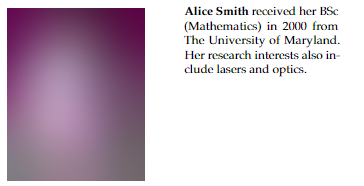
5. Figures, supplementary materials, and tables
5.1 Figures
Figures should be included directly in the document. All figures and tables must be called out in the text in the order they appear. All photographs must be in digital form and placed appropriately in the electronic document. All illustrations must be numbered consecutively (i.e., not by section) with Arabic numbers. The size of a figure should be commensurate with the amount and value of the information conveyed by the figure.
Authors must use one image file per figure. Figures must be inserted as objects that are fixed and move with the text, not as floating objects. Figures should never be placed in a table environment. All the figures should be centered, except for small figures no wider than 2.6 in. (6.6 cm), which may be placed side by side. Place figures as closely as possible to where they are mentioned in the text. No part of a figure should go beyond the text margins. The figure should not be embedded inside the text.
All figure captions should be centered beneath the figure. Longer figure captions should be centered beneath the figure and alignment double (left and right) justified, but are not to exceed the left and right edge of the figure by more than 0.5 in. The abbreviation "Fig." for figure should appear first followed by the figure number and a period. Captions should be in 8-pt. font. At least one line of space should be left before the figure and after the caption.
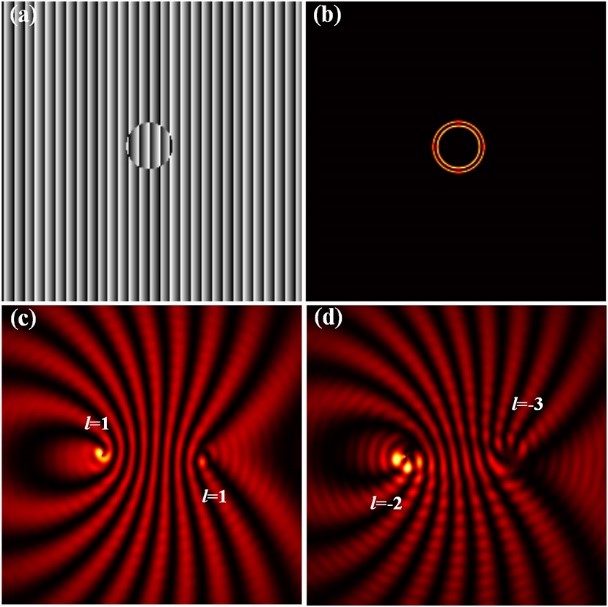
Copyright and permissions
If any figures have been previously published, it is important that authors request permission from the publisher (not from the author) and add the required permission line to the caption exactly as specified by the publisher. Use of images under an open license often still requires attribution. Please check the source for applicable terms for reuse. Note that images of people or images owned or trademarked by other entities (including well-known logos or cartoon characters for example) will also require official written permission for publication in our journals. Copies of all permission grants should be forwarded to the journal.
Use of the Lena image in Optica Publishing Group Journals
Authors are encouraged to avoid use of the Lena image. Authors who submit manuscripts to our journals that include the Lena image will be asked to justify the scientific necessity of using the image and why no reasonable substitute can be made. Authors are encouraged to use alternate test images. Other standard test images include, "Cameraman" or "Mandrill" or "Peppers" or a large number of other images distributed with packages like MATLAB and available in the public domain.
5.2 Supplementary materials in Optica Publishing Group journals
Our journals allow authors to include supplementary materials, such as additional text, figures and equations, multimedia files, machine-readable data tables, large data sets, and design and code files. Such materials are subject to the same editorial standards and peer-review procedures as the rest of the manuscript. Authors who wish to submit supplementary materials must adhere to Author Guidelines for Supplementary Materials in our journals.
To ensure consistent presentation, broad accessibility, and long-term archiving for multimedia files, please follow these guidelines on presentation.
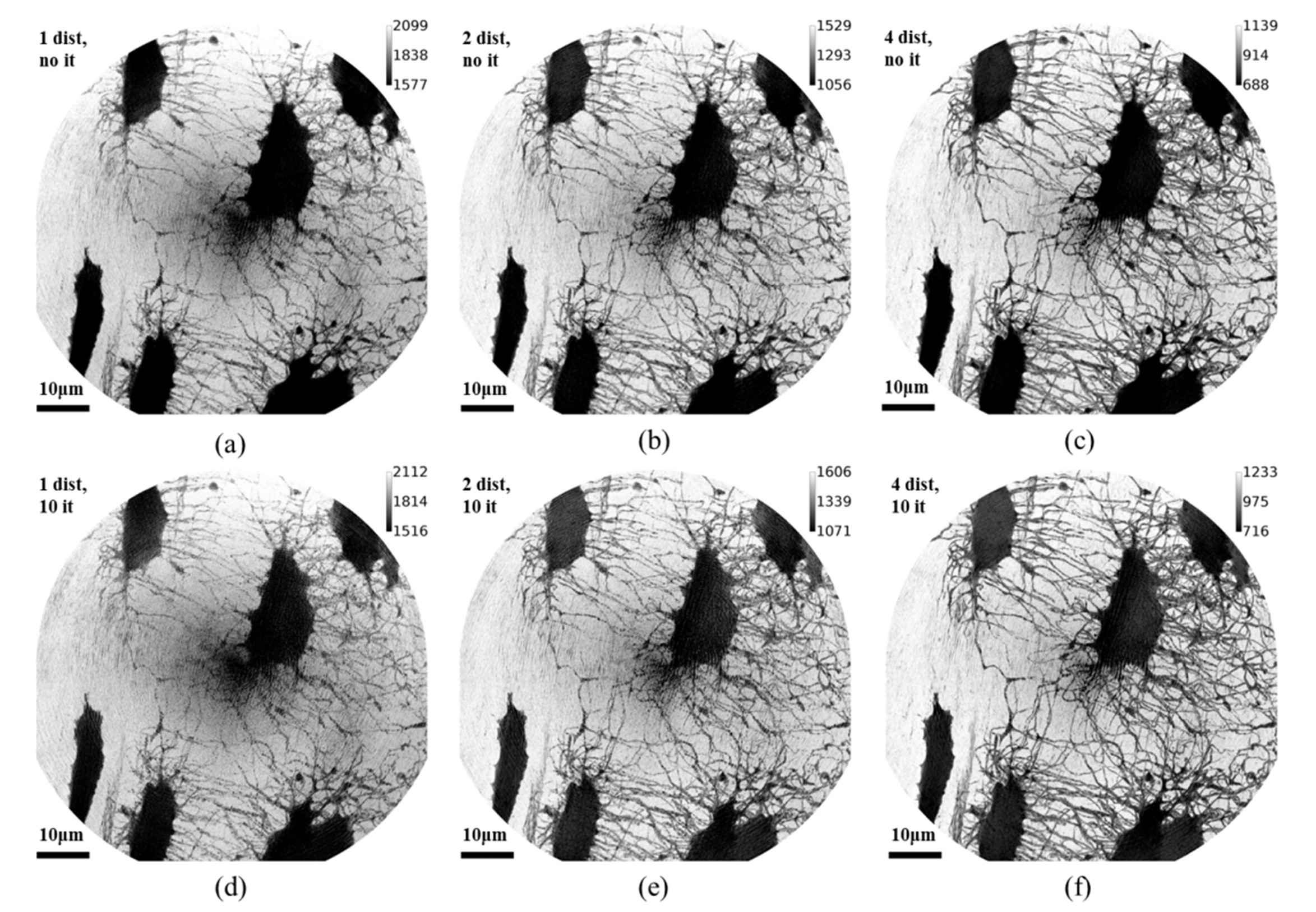
Video files must use open compression standards for display on broadly available applications such as VLC or Windows Media Player. MOV, AVI, MPG, and MP4 video containers are accepted.
The following multimedia guidelines will help with the submission process:
- 15 MB is the recommended maximum multimedia file size.
- Minimize file size by using an acceptable codec such as x264 or XviD. HandBrake is an open source tool for converting video to common codecs.
- 720 x 480 pixels (width by height) is the recommended screen size.
- If appropriate, insert a representative frame from the video in the manuscript as a figure.
- Videos must be playable on all platforms using VLC.
- Animations must be formatted into a standard video file.
Please refer to Author Guidelines for supplemental documents, audio, data files, code, and large datasets.
5.3 Tables
Tables should be centered and numbered consecutively. Authors must use Word's Table editor (or appropriate LaTeX markup) to insert tables. Authors must not import tables from Excel. Tables with multiple parts should be split into separate numbered tables [not Table 1(a), Table 1(b), etc.]. Tables should use horizontal lines to delimit the top and bottom of the table and column headings. Detailed explanations or table footnotes should be typed directly beneath the table, but not in a table cell. Table footnote labels should be text; numbers or special characters are not permitted. Position tables as closely as possible to where they are mentioned in the main text.
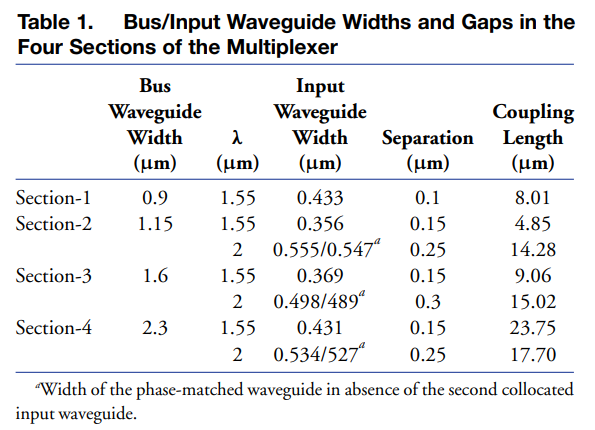
6. Article thumbnail upload
Authors are strongly encouraged to upload a thumbnail image to be used next to their article in the Table of Contents and abstract pages of the journal. Authors must submit a .JPG file. The image will be resized to 100 × 100 pixels. For best results, authors should upload an image this size or an image with square dimensions. No author photos are to be submitted; exceptions must be cleared by the Managing Editor.
The 100 × 100 pixel image will be displayed on the article abstract page, and a 50 x 50 pixel image will be displayed on the Table of Contents page.
Although a replica of the image does not need to appear in the manuscript itself, it must have a strong connection to the research contained within the paper and must be the property of the author(s) of the current paper. This means that even if the article does not contain figures, a thumbnail can still be submitted as long as it relates strongly to the research and is original. Images containing institution or corporate logos should not be submitted.
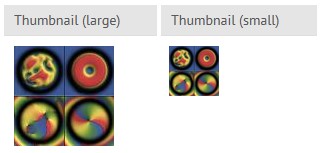
7. Quality of English
If a student-level reader might find your English difficult to understand, please have a colleague who is fluent in English edit your paper or consider using a language editing service (e.g., https://languageediting.optica.org/) before you submit it to us. A poorly written manuscript will most likely be rejected without external review, so addressing language deficiencies before submission is important.
8. Letter Paper Length
Note that Optics Letters and letters papers in Optica have a limit of four printed pages. Optica memoranda have a two-page limit. If a paper exceeds this limit, it must be shortened before the paper is accepted. If the page proof is over the four-page limit, the proof must be shortened before the paper can be assigned to a final issue. Authors should use the appropriate Legacy Word or LaTeX templates to prepare Letters and Memoranda to facilitate length checking.
9. Final Remarks
Authors will receive an e-mail notification to download page proofs of their papers. Corrected proofs should be returned following the instructions in the notification as soon as possible, preferably within 24 hours of receipt, to avoid publication delays.

